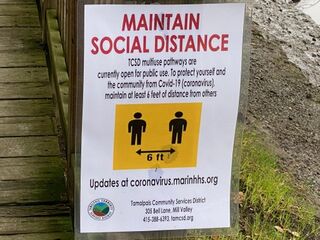Anxiety
Do You Have COVID Re-Entry Anxiety?
Five ways to rebuild your personal connections as you navigate the new normal.
Posted October 17, 2021 Reviewed by Jessica Schrader
Key points
- After months of COVID restrictions, many of us are feeling anxious about connecting with others.
- Research has found how personal connections are vital for our physical and emotional health.
- Connection with others doesn’t just happen, but there are ways to safely reconnect.

I was walking my dog near my house when I saw a neighbor walking toward me on the sidewalk and crossed the street to avoid him. Then the thought struck me—here I was in my own neighborhood, reacting defensively, anxious about getting too close. Taken to extremes, the clinical term for this reaction is agoraphobia, fear or anxiety about being outside the home, in a crowd, or in public places (American Psychiatric Association, 2013). The difference, during these times, is that COVID-19 health directives have urged us to wear masks and avoid unnecessary interactions.
Now, as more of us are vaccinated and many workplaces, restaurants, and public events are opening up, many of us are feeling anxious connecting with the people around us, experiencing what has been called “COVID-19 re-entry anxiety” (Bradley, 2021). The long months of social distancing, remote work, and COVID restrictions have broken our natural chain of personal connections.

We’ve gotten out of the habit of connecting with each other. Yet research has found that personal connections are essential for us to live a healthy life (Fredrickson, 2013; Seligman, 2011; Umberson &Montez, 2010). These connections include not only close relationships with friends and family but what Barbara Fredrickson has called “micro-moments of connectivity” with our neighbors, the grocery store clerk, or anyone we encounter in daily life. With a simple smile, eye contact, presence, perhaps a kind word, these connections benefit both people. They can dramatically improve our health, raise our mood, relieve stress, and reduce inflammation to promote greater physical and emotional well-being (Fredrickson, 2013).
As we navigate our new normal, we need connection and community to build a more hopeful future for ourselves and our world. The Hopeful Mindsets project has found that cultivating a supportive network of friends, family, and neighbors is one of the five keys to restoring our hope (iFred, 2021). Our challenge is, "How can we stay safe while rebuilding our personal connections?”
Connections don’t just happen. Like plants in our gardens, relationships need attention and cultivation in order to flourish. Begin connecting gradually, one small step at a time, mindful of your feelings, your health, vaccine status, and life situation. You could practice “micro-moments of connectivity” at work or when you’re out doing errands. Exchange greetings with your neighbors at a safe distance. Reach out to friends in a way that feels comfortable. You could connect with a text or phone call, arrange a Zoom visit, meet for a walk or coffee at an outdoor café. Then you can begin cultivating your connections with these five steps inspired by the Hopeful Mindsets Project (iFred, 2021):
- Listen with empathy to the people around you. Often, the best gift you can give someone is simply letting them know they’ve been seen and heard. Ask how they feel, then take a deep breath and just listen, reflecting back what you’ve heard. If your sister tells you she’s feeling tired, instead of automatically giving advice or starting to tell your own story, simply say, “it sounds like you’re feeling exhausted.” Then listen to what she says.
- Follow the 5:1 rule. Give five positive comments for every critical one. Consciously look for the good in the people around you and point it out. This will not only improve your relationships and build your hope, but increase the positivity around you. Psychologists know that giving positive reinforcement for a behavior increases it (Numan, personal communication, 2021).
- Perform simple acts of kindness. Do this not only with family and friends but also when you’re out doing errands. Hold the door open for a person carrying packages or let someone with only a few items go ahead of you in the grocery store line. Challenge yourself to perform at least one act of kindness each day.
- Forgive yourself and others. Our negative feelings are important signals. Fear helps us avoid danger, anger helps us stand up for ourselves, and guilt helps us recognize we’ve done something we regret. The key is to listen and learn from these signals, rather than to dwell on them. We all make mistakes. When you think of a past mistake, give yourself self-compassion, realizing it’s only human to make mistakes and forgive yourself (Neff, 2011). Ask yourself what you can learn from this experience, what you can do better next time. Then visualize yourself taking this step and move on. The same process holds true when others have hurt or disappointed us. If you’ve been harboring feelings of hurt, anger, or resentment, ask yourself to consider one thing you’ve learned from this experience, and what you can do in the future. This may mean standing up for yourself and setting better boundaries (Neff, 2021). Recognize what you've been feeling, give yourself self-compassion, then release the negative feelings, and move on.
- Focus on the quality of your connections as you begin reaching out to the people around you. Your close connections are your hope network, one person or a group of people you can count on to listen to you, support you, and encourage you to reach your goals (iFred, 2021). These are the people you can open up with and share your deepest feelings. Someone who puts you down, makes you feel inferior, or drains you with negativity is only an acquaintance, not someone for your hope network. Cultivate your hope network intentionally, reaching out, listening, sharing, and supporting one another as you build greater hope together.
By following these steps, you can reach out safely and mindfully to create greater connection, community, and hope in your life.
_________________
This post is for informational purposes and should not substitute for psychotherapy with a qualified professional.
To find a therapist, please visit the Psychology Today Therapy Directory.
References
American Psychiatric Association. (2013). DSM-5: Diagnostic and statistical manual of mental disorders. 5th Edition. Arlington, VA: American Psychiatric Association.
Bradley, S. (2021, May 27). Why you have COVID-19 reentry anxiety and what to do about it. Singlecare.com. https://www.singlecare.com/blog/news/life-after-covid-19-reentry-anxiety/
Florin, F. (5 April 2020). Tamalpais Community Services District social distancing sign at Richardson Bay.Wikimedia Commons.
https://www.flickr.com/photos/fabola/49823698411/
Fredrickson, B. (2013). Love 2.0: How our supreme emotion affects everything we feel, think, do, and become. New York, NY: Hudson Street Press.
International Foundation for Research and Education on Depression (iFred). (2021). The Hopeful Mindsets Project. https://hopefulmindsets.com/
Michel, C. (10 Sept 2014). Best friends. Wikimedia Commons.
Neff, K. (2011). Self-compassion: Stop beating yourself up and leave insecurity behind. New York, NY: William Morrow.
Neff, K. (2021). Fierce self-compassion: How women can harness kindness to speak up, claim their power, and thrive. New York, NY: Harper Wave.
Numan, R. (2021, October 12). Professor of Psychology, Emeritus, Santa Clara University. Personal communication.
Seligman, M.E.P. (2011). Flourish. New York, NY: Free Press.
Umberson, D., Montez, J. K. (2010).Social relationships and health: A flashpoint for health policy. Journal of Health and Social Behavior, 51 (1), S54 - S66.


